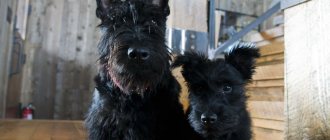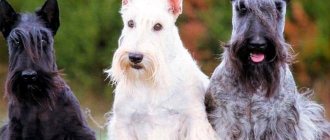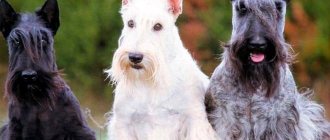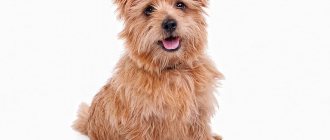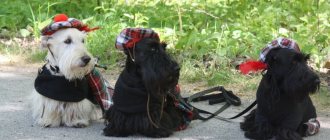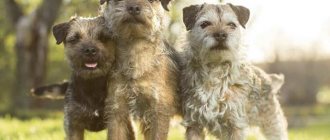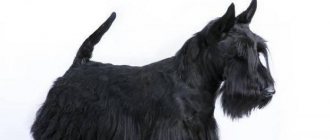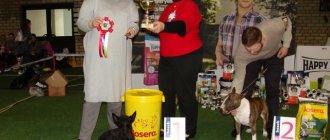The breed is quite old, but it finally took shape in the 19th century. It got its name due to its place of origin: the phrase “Scottish Terrier” is translated as “territory of Scotland” (English: scottish terrier) or “Scottish land”. Pets are distinguished by an interesting character that harmoniously combines a variety of traits - restraint and playfulness, nobility and the ability to stand to the end, calmness and the classic hunting instinct. Let's figure out what the future owner of such a dog needs to know about the breed.
History of the Scottish Terrier breed
Scottish Terrier
Despite the fact that Scotties are considered the oldest dog breed in Scotland, they managed to stand out from the large clan of terriers only in the middle of the 19th century. It was during this period that the paths of the short-legged Scottish and long-haired English terriers diverged, and they finally stopped crossing with each other. However, the matter never came to a real classification, so for several decades, Scottish terriers were called any dogs that specialized in catching barn rats and burrow hunting. And, as you know, West Highlands, Skye, and even Cairn terriers did this quite successfully. The process of formation of the breed was slowed down by spontaneous breeding. According to contemporaries, every Scottish village of the 19th century had its own ideal type of terrier, often the carrier of an unimaginable mixture of genes inherited from a dozen other breeds.
Scotch terriers began to form a separate family in 1879, after the decision of the English Kennel Club to distinguish Scottish terriers into classes based on their colors. History has even preserved the name of one of the first breeders, who played a vital role in separating Scotch Terriers from their fellow breeders. He turned out to be a certain Captain McKee, who in 1880 traveled around the Scottish provinces and bought animals with wheat and black shades of wool from peasants. It was thanks to his efforts that in 1883 the Scottish Terriers finally received their own breed standard, completely separating themselves from the snow-white West Highlands and the mazury natives of the Isle of Skye.
Scottish terriers came to the United States in the 80s of the 19th century, but at first they didn’t really catch anyone’s attention. Only after Franklin Roosevelt himself acquired a representative of this breed did the Scottie receive universal recognition and love. Scotch terriers were brought to Tsarist Russia at the beginning of the 20th century, so the first owners of these shaggy “gentlemen” were members of the grand ducal family. However, the country was soon swept by the whirlwind of revolution, and the animals were quickly forgotten. The second attempt to win the hearts of Soviet dog lovers was made by the breed in the 30s, but again it did not reach the point of large-scale breeding, since the sudden outbreak of the Great Patriotic War did not contribute to such experiments. So, the USSR began to fully “stamp” Scottish terriers only in the mid-70s, when several foreign breeding bitches and males arrived at the Krasnaya Zvezda kennel.
Famous Scottish Terrier owners:
- George W. Bush;
- Mikhail Rumyantsev (clown Pencil);
- Victor Tsoi;
- Leonid Yarmolnik;
- Vladimir Mayakovsky;
- Leonid Utesov.
Appearance of the Scottish Terrier
Scotch Terrier puppy
The Scottish Terrier is a squat, shaggy “Scot” with a stylish, slightly unkempt beard and short legs that masterfully cope with digging out even the hardest ground. Belonging to the group of small terriers, Scotties cannot boast of an impressive build, but they cannot be called real midgets either. The average height of an adult dog is 25-28 cm, weight is up to 10.5 kg, and these parameters are the same for both males and females.
Head
The Scotch Terrier's skull is elongated, almost flat, with a distinct stop that matches the eyes.
Teeth and bite
All representatives of this breed have very large teeth, and the jaws are closed in a full, scissor bite (the upper incisors completely cover the lower dentition).
Nose
The Scottish Terrier's nose is massive and rich black in color. The line running from the lobe to the dog's chin has a slight slope.
Eyes
The Scotch Terrier's wide-set, dark brown eyes are almond-shaped and slightly covered by overhanging eyebrows. The dog's gaze is inquisitive, perceptive, perky.
Ears
Scottish terriers have elegant and very thin erect, pointed ears.
Scottish Terrier in a cute sweater
The Count and his estate
Neck
The dog's neck is not overly elongated and moderately muscular.
Frame
Scotch Terrier muzzle
The Scotch Terrier's back is short, with a flat, almost horizontal top line. The chest of representatives of this breed is wide, noticeably protruding forward and slightly lowered towards the bottom.
Legs
The forelimbs are short, with straight, bony forearms and level pasterns. The hind legs are more massive, with large hips and short but strong hocks. The dog's paws are arched, balled, with large pads. Despite its pronounced short legs, the Scotch Terrier copes with loads quite successfully: a forced march of 10 km and an hour and a half of digging a pit for a Scottie is far from the most difficult work.
Tail
Wheaten Scotch Terrier
The Scotch Terrier has a small (16-18 cm) tail, thickened at the base, which is carried almost vertically. A slight tilt is also acceptable.
Wool
The Scottish Terrier's coat is formed by a short, close-fitting undercoat combined with a wiry outer coat. The fur reaches its greatest length and thickness in the lower part of the dog’s body, forming the so-called “skirt” and “pants”.
Color
The correct Scotch Terrier can be black, wheaten in all its variations or brindle colors. Moreover, in the case of brindles, all types of shades are considered acceptable.
Disqualifying faults
Everything here is the same as with representatives of other breeds: the exhibition commission can exclude an animal from the list of competitors for pronounced physical defects or for behavioral deviations. In particular, overly cowardly and overly aggressive Scotch Terriers are definitely not going to get into the ring.
Neapolitan
Height: 60-75
Weight: from 50 to 70 kg
Other names are Italian, or Mastino Neapolitan. The Italian is characterized by slowness and serenity, which is simply ideal for a lazy owner. Neapolitans become attached to a person with all their hearts and love to lie with him in an embrace on a soft sofa. However, these dogs are distinguished by their willpower, intelligence and strength of character.
Photo: dogsnsw.org.au
The Mastino Neapolitan is not the ideal dog for a novice dog breeder. It is also not recommended to have an Italian in a house where there are small children. The dog may not understand that you are playing with the child, and will insistently stand up for him in such a way that it won’t seem too much.
Photo of Scotch Terrier
Character of the Scotch Terrier
The Scottish Terrier is a dog with character and a pronounced Napoleon complex, so don’t expect to raise him into a sentimental lazy person and a couch sissy. Non-stop hugging, lazy lying on the owner's lap - this is not about Scotch terriers. Proud and independent, they will not allow themselves to be turned into a living toy, no matter what privileges and delicacies loom before them.
Santa and his elf
However, it’s also not worth putting Scotties in the category of insensitive crackers, because for all their obstinacy they experience an almost pathological attachment to their owner. Moreover, these bearded “energizers” are not at all averse to fooling around, lying on the bed together or taking on the function of a shaggy hot water bottle, but for this they need to wait for the appropriate mood. Scotch terriers cannot and will not love under force or command.
Scottish terriers are extremely curious, so they really need fresh impressions, which they try to stock up on for future use during walks. So, just accept that when you go outside, Scotty will search all the holes and potholes for living creatures. If none are found, the dog will definitely try to compensate for the failure by destroying flower beds and lawns. But at home, the Scotch Terrier is a model of equanimity and good manners and can spend hours looking out the window, watching the drizzling rain and thinking about something of its own.
Let's be friends!
Representatives of this breed are extremely intelligent and do not suffer from excessive importunity: if the owner is sitting at work or watching an action-packed film, the Scottie will not flicker before his eyes in an attempt to divert his attention. As a last resort, he will simply sit next to you, hinting that he is ready to share his leisure time. And for Scottish terriers, an emotional connection with the owner is very important, so often involve the dog in spending time together, whether it’s cooking barbecue in nature or simply washing the floors.
The more an animal comes into contact with humans, the faster it develops, and vice versa - the less attention is paid to the Scotch Terrier, the more it withdraws into itself and becomes stupid. If a “Scottish” whiles away his days alone, in an enclosure, because you are too busy with work or organizing your personal life, don’t even hope that he will grow up to be a friendly intellectual. The most you can hope for is a hot-tempered brawler who hates tactile contact in all its forms. By the way, about fights: getting involved in them is as natural for Scotch Terriers as, for example, digging a hole. Moreover, the Scottie absolutely does not care about the size of the enemy - he will attack the Alabai with the same fury as the Chihuahua.
Tibetan
Height: 61-77 cm
Weight: 60-80 kg
In another way it can be called “Siberian”. It was bred approximately 2-3 thousand years ago in India, China and Nepal to protect sheep from leopards. It is worth saying that the Tibetan mastiff has carried its qualities as a protector through the centuries.
Photo: dogsnsw.org.au
This breed has an independent character. Die-hard, to be honest.
If a dog is confident that he is right, he doesn’t care what his owner wants from him. The Tibetan Mastiff is a dog with an inflated ego. She does not like it when her personal boundaries are violated and they treat her in a familiar manner - except for the recognized owner.
Another distinctive feature of this breed is its intolerance to children’s crying. The dog may react inappropriately, deciding that loud screams are aggression towards him.
But the big Tibetan mastiff is a real beauty. The colors of the Tibetan Mastiff are red, black and tan and pure black, the latter looking especially luxurious.
Education and training
Extremely intelligent, but extremely stubborn, does not tolerate criticism, but is very sensitive to praise and flattery - this is all you need to know about the Scotch Terrier's learning abilities. At first, Scottie is actively involved in the training process, but as soon as the lessons begin to lose the effect of novelty, the dog moves on to other, more interesting activities. Another trait of the breed that is not the most pleasant for a dog handler is selectivity. The Scottish Terrier can perfectly follow commands that involve some exciting action (“Look!”) and willfully ignore boring options like “Sit!” You will have to get out of the situation with the help of gentle persuasion and treats; other methods have little or no effect on Scotties.
Waiting for a reward
There are no special programs for training Scotch Terriers, although breeders never tire of repeating that teaching a “Scot” using the classical method is just a waste of time. It is better to combine play and study, cutting down the lesson time as much as possible. Scottish Terriers are not the kind of dogs that work through force, overcoming boredom and fatigue. For the same reason, there is no point in taking them to the training ground: classes there last a long time, which is already unbearable for representatives of this breed.
In order not to chase a pet driven by its hunting instinct while walking, accustom it to walking on a leash before going outside, that is, from the age of three months. Consider also the fact that young Scottish Terriers are quite destructive, and there is no cure for this. Hide your expensive shoes for a while and avoid making too much repairs until your dog is older. It is not forbidden to lightly spank puppies that are too insolent and presumptuous with a newspaper/rag, but the method only works if the young troublemaker understands why he is getting a “bun”.
It is known that little “Scots” love to bite, but you should not condone such outbursts of aggression, nor should you abuse negative reinforcement during the puppy’s training. It is other dogs that perceive the owner’s cry as a stimulus. For the Scotch Terrier, such signals are a reason for unnecessary frustration and resentment. And one more thing: do not expect that in the very first lessons your child will begin to demonstrate miracles of intelligence. This is a breed that needs to first evaluate the appropriateness of the given command and only then carry it out, so do not burden the puppy with repeated repetitions of exercises and endless demands.
Interesting Facts
The Scottish Scotch Terrier attracts its fans due to its funny appearance and “British” character. Not surprisingly, many unusual facts are known about this dog:
- The Scottish terrier was kept by 2 US presidents - T. Roosevelt and D. Eisenhower.
- The terrier was the companion of the brilliant physicist A. Einstein.
- This cute dog has repeatedly attracted the attention of writers. Thus, the Scottish terrier became the hero of R. Kipling’s book “Your Faithful Dog Boots.” This adventure story about 2 dogs has been translated into several languages, including Russian.
- Of course, the Scotch Terrier also became the hero of films. Fans of old cinema will probably remember that in the Soviet TV series “The Adventures of Sherlock Holmes,” a black Scottish terrier was the favorite companion of Inspector Lestrade, played by Bronislav Brondukov. True, the screen dog, according to the script, died suddenly due to the fact that the unlucky policeman confused the medicine with poison.
- The legendary clown Pencil often performed acts with the participation of his assistant Scotch, nicknamed Blob. Few people know that in fact her role was played by 17 similar understudies.
- The Scotch Terrier also became the “face” of Scotch whiskey under the Black&White brand.
This is interesting! The dogs earned the affectionate name “Scotty” long ago, when they were best friends for hunters, and now this nickname is also in use.
Hunting with a Scottish Terrier
Today's Scotch Terriers rarely hunt, but not because of the loss of the pursuit instinct, but rather because of the reluctance of the owners to engage with the dog. Modern breeders rely on the image of their pets, therefore, not every owner is ready to allow their glamorous handsome dog to dig and get dirty in the ground. However, if the instinct of a getter is your everything, and you don’t mind slightly spoiling the external gloss of your “Scot,” visit the baiting stations, if there are any in the area. There, the Scotch Terrier will quickly be reminded of his main purpose, and in a month or two a highly qualified fox catcher and conqueror of the deepest holes will walk next to you.
It's time to hunt...
Where is this fox?
Maintenance and care
Caught the ball
Scottish Terriers feel great in small apartments, provided they are given good exercise. As for the placement of the puppy, kennel owners recommend placing the Scottish Terrier in the same room with the owner, because this breed needs close emotional contact with a person. And this way it will be easier for the puppy to remember who his older friend and teacher is now. It is better to select a Scottie bed with low wooden sides (up to 10 cm) and install it so that it rises a couple of centimeters above the floor. This will protect your pet from treacherous drafts. Toys should also be present in the life of a Scottish Terrier, but if necessary, they can be replaced well by an ordinary apple or a cabbage stalk.
The floor in the room where the Scotch Terrier puppy lives will have to be covered with rugs or newspapers for the first time. On slippery surfaces, the baby’s paws move apart, and as a result, the dog develops an incorrect posture. Speaking of handling: until the Scottish terrier matures, take him out for walks on a leash, and not on a harness, which deforms the baby’s already weak forelimbs. And in general, it is better to refuse this accessory if neither you nor your pet plans to “rock” in the ring in the future.
Walks
The Scottish Terrier is not a breed for adepts of passive pastime, if only because up to six months you will have to walk the puppy every two to three hours. From six months to one and a half years, Scotties are taken outside up to four times a day. After the puppy turns one and a half to two years old, you can switch to regular walking twice a day, with the duration of each excursion being at least two hours. If you don’t want to hang out in parks and squares for so long, take your four-legged friend to the boardwalk three times a day, reducing the time of one walk to 60 minutes.
Scottish Terriers love long walks
Hygiene
There is no seasonal shedding in Scottish Terriers. Twice a year, the animals' undercoat is renewed, but the guard hair remains in its proper place and dies off gradually. In this regard, Scotch Terriers are not cut, but trimmed, removing tufts of loose hair. Typically, plucking is done twice a year in a grooming salon, where a specialist not only removes dead undercoat from the dog, but also gives its silhouette the necessary breed characteristics. However, some breeders recommend not limiting themselves to seasonal grooming, but periodically plucking the Scottish Terrier yourself (once a month), removing dead hair all over the body.
Important: the Scotch Terrier’s first acquaintance with the procedure of plucking hair should take place no earlier than the animal is six months old.
Bath procedures
The most common mistake when grooming a Scottish Terrier at home is leaving too much undercoat on its “pants” and “skirt.” Scotty is not a lapdog, and he has no use for flying hair on his thighs. Scottish Terriers need to be bathed once a month, washing the coarse hair with a nourishing pet shampoo and moisturizing it with conditioner or leave-in cream to make combing easier. But this is all in theory. In practice, you have to wash the restless “Scots” almost five times a day. Not only does the Scotch Terrier’s “skirt” collect liquid dirt during walks, but the pet itself strives to dig into the ground and generously sprinkle it on its own “fur coat.” Partially solving the problem of soiled fur is purchasing protective overalls, but only partially, so get used to the fact that this breed cannot be treated without daily water procedures.
A little about brushing Scottish Terriers. You can only tidy up clean fur: never try to comb a dirty dog that has suddenly discovered tangles. First, wash the animal thoroughly, and you may not have to fight with matted fur at all. Scotch terriers are combed in two steps: first with a brush, then with a wide-tooth comb. Pieces of wool that cannot be untangled can be carefully removed with a tangle cutter. If the structure of your ward’s decorative hair leaves much to be desired, try rubbing an oil mixture with the addition of rosemary esters into the coat; it has not only a stimulating, but also a slight dirt-repellent effect, which is extremely important for Scotch terriers.
Be sure to keep your dog's beard clean. Wipe your pet's face after each feeding, or even better, buy him a special flat food bowl and a water bottle. Scottie's ears are healthy, so caring for them is not burdensome - just a simple weekly cleaning of the ear is enough. The dog's claws and eyes will require a little more attention. The first ones grow very quickly, so they need systematic cutting. The latter may react with inflammation to external irritants; therefore, periodically it may be necessary to wash the mucous membrane with chamomile or tea infusion.
Feeding
Where's the food?
The main source of protein for an adult Scottish Terrier is lean, raw beef. Lamb, like pork, is a time bomb for the liver and guaranteed diarrhea, so we immediately discard them. Boiled offal can be a good alternative to beef, but not more than a couple of times a week. By the way, Scottish terriers usually do not suffer from allergies, so turkey and skinned chicken are not prohibited for them.
Three to four times a month, the Scotch Terrier is pampered with boiled sea fish without bones. In addition, the dog’s menu should always include low-fat fermented milk products. Buckwheat and oatmeal are useful cereals for Scotties, and carrots and cucumbers are useful for vegetables. Rice is also considered a nutritious grain, but the “Scots” have problems with stool from it. Natural dietary supplements like bone meal (just bones are prohibited) or vegetable oil will be a good support for the body, although mineral supplements from a pet store are also not the worst option.
If you plan to feed your Scottish Terrier dry food, give preference to the super-premium and holistic class. With this type of nutrition, taking additional vitamin and mineral complexes is not required.
And of course, you need to carefully monitor the dog’s condition. If your pet has lost a little weight but is quite healthy, put more food in his bowl. The lazy people occupying the sofa, on the contrary, should cut their rations.
Mayorsky
Height: 52-58 cm
Weight: 30-34 kg
He's a ca-de-bo. Homeland - the island of Mallorca (Spain). The most common kind and devoted dog that loves small children and gets along well with all members of the household. The ca-de-bo will show aggression only when absolutely necessary, when the life of the dog itself or its owner depends on it.
Photo: en.wikipedia.org
In the past, large Major Mastiffs took part in Spanish bullfights, hence the name: “ca de bou”, i.e. "bull dog"
During separation from the owner, the ca-de-bo will make the most logical decision - go to sleep until the person comes back
. But at the same time, the breed requires activity and systematic walks.
How to choose a puppy
I like this place
- Eight-week-old Scottish Terriers are extremely difficult to check for compliance with the standard, since puppies begin to acquire breed characteristics only in the fifth or sixth month of life. That is why it is important to contact an honest, trusted nursery, where all offspring are obtained from planned matings and are necessarily registered.
- If you are afraid of making a mistake in your choice, look for a breeder who sells six-month-old teenagers. At this age, it is much easier to determine the prospects of a Scottish terrier, but such a puppy will also cost many times more than his two-month-old brothers and sisters.
- In Scotch Terrier puppies, the head is disproportionately developed and looks too massive. This is fine. If a two-month-old baby looks fully formed and looks like an adult animal, this is far from an advantage. Growing up, such individuals, as a rule, have lightweight bones and a short skull.
- Check how healthy the puppy you like is. Look into his ears and the area under his tail: both there and there should be clean. There should be no redness in the groin cavity and under the armpits.
- Assess the type of temperament of the kids and their habits in the group. Too shy and slow Scotties are an unenviable acquisition.
- Avoid buying a puppy that is too shaggy and has a well-furred skull, since with age it will most likely turn into a soft-haired fluffy dog, which is a serious defect for Scotch Terriers. It’s better to take a closer look at babies with smooth fur, without traces of grooming hair.
Photos of Scottish Terrier puppies
Scotch Terrier price
The cost of Scottish Terrier puppies is determined not only by their belonging to a certain class (pet, show, breed), but also by the color of the animals. For example, there are always more advertisements for the sale of Scotties with black wool, and accordingly, their prices are lower: about 30,000 - 35,000 rubles. Wheaten Scotch Terriers are a less common phenomenon due to difficulties in breeding, but they are more expensive - from 40,000 rubles per puppy. The most expensive option is show-class Scottish terriers with breeding rights. The price for these representatives of the canine elite ranges from 80,000 - 100,000 rubles.
Spanish
Height: 72-77 cm
Weight: 80-85 kg
The Spanish were used as shepherds in the past. Thanks to nerves of steel, a stable psyche and a good mind, they looked after the cattle, steadfastly endured the long absence of water and food in the mountainous areas and always returned the entire herd to the owner intact.
Photo: doglime.com
Like other mastiffs, Spaniards are devoted to their man and are ready to sacrifice their own lives for him. Although they look like formidable giants, their loving nature is enough for the whole family - even more.
